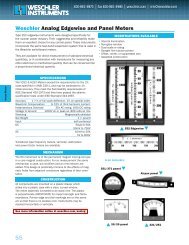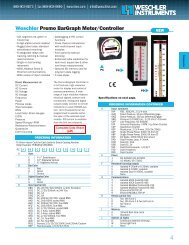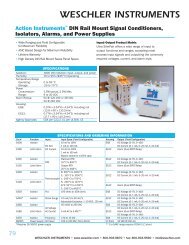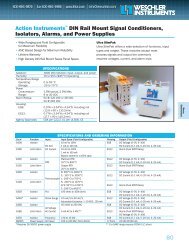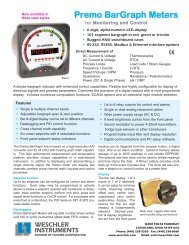WWW.MEGGER.COM
A practical guide to earth resistance testing - Weschler Instruments
A practical guide to earth resistance testing - Weschler Instruments
You also want an ePaper? Increase the reach of your titles
YUMPU automatically turns print PDFs into web optimized ePapers that Google loves.
SECTION IEarth ResistivityThe term “earth resistivity” expressed in ohm-centimeters (abbreviatedohm-cm) is one basic variable affecting resistance to earth of an electrodesystem. But the actual value of earth resistivity need not be measured tocheck the electrode earth resistance. Consider other fields where the valueof resistivity is measured; also some of the factors affecting it that are ofinterest in earth testing.Earth resistivity measurements can be used conveniently for geophysicalprospecting — to locate ore bodies, clays, and water-bearing gravelbeneath the earth’s surface. The measurement can also be used todetermine depth to bed rock and thickness of glacial drift.Measurements of earth resistivity are useful also for finding the bestlocation and depth for low resistance electrodes. Such studies aremade, for example, when a new electrical unit is being constructed; agenerating station, substation, transmission tower, or telephone centraloffice.Finally, earth resistivity may be used to indicate the degree of corrosionto be expected in underground pipelines for water, oil, gas, gasoline,etc. In general, spots where the resistivity values are low tend to increasecorrosion. This same kind of information is a good guide for installingcathodic protection.How Earth Resistivity is MeasuredA four-terminal instrument is used to measure earth resistivity. Now,however, you use four small-sized electrodes driven down to the samedepth and equal distances apart in a straight line (Fig. 1). Four separatelead wires connect the electrodes to the four terminals on the instrument,as shown. Hence, the name of this test: the four-terminal method.Fig. 1: Four-terminal method of measuring earth resistivityDr. Frank Wenner of the U.S. Bureau of Standards (now NIST) developedthe theory behind this test in 1915 (see reference pg. 76). He showedthat, if the electrode depth (B) is kept small compared to the distancebetween the electrodes (A) 1 , the following formula applies:ρ = 2π ARwhere ρ is the average soil resistivity to depth A in ohm-cm, π is theconstant 3.1416, A is the distance between the electrodes in cm, and R isthe Megger earth tester reading in ohms.In other words, if the distance A between the electrodes is 4 ft, you obtainthe average earth resistivity to a depth of 4 ft as follows:1. Convert the 4 ft to centimeters to obtain A in the formula:4 x 12 x 2.54 cm = 122 cm2. Multiply 2 π A to obtain a constant for a given test setup:2 x 3.14 x 122 = 766Now, for example, if your instrument reading is 60 Ω, the earth resistivitywould be 60 x 766, or 45,960 ohm-cm.1 B = 1/20A is generally recommended6 1-866-254-0962 www.megger.com Getting Down to Earth 7



